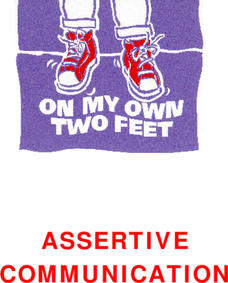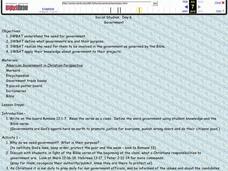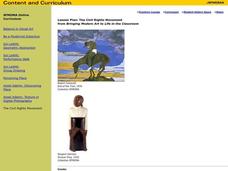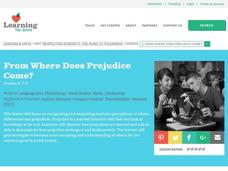Curated OER
Windows and Mirrors: Examining Pictures Through a Human Rights Lens
Young scholars select a picture from a given set and participate in a discussion about the picture. Students discuss the rights from the Universal Declaration of Human Rights that can be associated with their pictues. Young scholars...
Department of Education (Ireland)
Assertive Communication
Assertive communication is an acquired skill. Teaching young people to ask for what they need and to believe that they have a right to ask is at the core of a unit on assertive communication. Over the course of the unit, middle and high...
Curated OER
Government
Perfect for a Christian or private school setting, this activity has learners use their Bible to help them identify the purpose of the government. They examine specific Bible verses then use them to define the government and the...
Curated OER
The Civil Rights Movement
Learners compare and contrast African-American, Asian-American, Chicano and Native-American movements with the civil rights movement and are exposed to the sociopolitical and economic factors involved in the rise of social movements.
Curated OER
Anne Frank: Interviews
Students conduct an interview with a person who was alive during WWII. They explore the media coverage of human rights abuses and speculate about what American knew and when regarding the Holocaust. They prepare a commentary with their...
Curated OER
Introduction to the UN
Students read the story UN wins Nobel Peace Prize, this is a way to introduce the United Nations and find out what Students already know. Students draft a formal letter to Kofi Annan the UN Secretary-General which include personal...
Curated OER
The U.S. Constitution and Disability Laws
Young scholars examine the United States Constitution for laws that protect people with disabilities. They discover how the education system provides equal education to all students and how the Federal Government makes sure this is...
Curated OER
Prejudice and Discrimination
Learners are read-aloud an excerpt from The Friendship by Mildred Taylor. They pick strips of paper, white or brown, and sit according to color drawn. Students are given preferential treatment if their paper is white while the learners...
Curated OER
Lesson One: "Full Court Press"
Students watch video clip about high school basketball hero who bullied some students, and was killed as result of his bullying. Students then describe and discuss impact of bullying in schools, determine who in the community has power...
Curated OER
The United Nations
Students are introduced to the role of the United Nations. Using the internet, they research its history and its influence on politics and peace. In groups, they create a timeline of significant United Nations conventions since World...
Curated OER
From Where Does Prejudice Come?
Learners explore the concept of discrimination. In this social studies lesson, students view pictures and write down the first thing that comes to their mind. Learners discuss if stereotyping or prejudice affected their first...
Curated OER
Full Court Press
Students watch a video clip about bullying, discuss the video, and help develop an anti-bullying policy for their school.
Curated OER
dsfa
Learners work in groups examining the school's policy of no weapons on school property.
Curated OER
We Are Divine Creations (Tolerance)
Students learn ways people volunteer and the ways it helps their self and spirit. In this service project lesson plan, students define tolerance and study people or organizations who have demonstrated tolerance. Students then answer...















